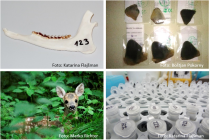
Laboratory for Forest Ecology
is a part of Department of Forest Ecology
Head of laboratory
Katarina Flajšman
Tel.: +386 1 200 78 63
Fax.: +386 1 257 35 89
 The Laboratory for wildlife and game management (LWGM) is specialized laboratory to perform studies on reproductive potential of different game and wildlife species (roe deer, wild boar, red deer, red fox).
The Laboratory for wildlife and game management (LWGM) is specialized laboratory to perform studies on reproductive potential of different game and wildlife species (roe deer, wild boar, red deer, red fox).
| Fields of research |
|---|
| Studies on reproductive potential of females of different game and wildlife species |
| Determination or estimation of age of different ungulate species, using the tooth eruption and tooth wear method |
| Perform macroscopic determination or estimation of age of different ungulate species |
| Cooperation with the hunting-ground managers from the area of the whole Slovenia |
Reproductive potential
Within the laboratory, we perform studies on reproductive potential of females of different game and wildlife species, eg. based on the macroscopic inspection of reproductive organs. We have years of experience on determination of reproductive potential of wild ungulate females (roe deer, wild boar, red deer) and also some other species (red fox).
We use the following methods:
- determination and counting of corpora lutea in ovaries;
- placental scar counts;
- determination and counting of foetuses in uteri;
- sex determination of foetuses.
Estimation of age
We perform macroscopic determination or estimation of age of different ungulate species, using the tooth eruption and tooth wear method. Based on the inspection of tooth and mandibles, we also determine the presence of various diseases and anomalies which reflect the exposure to different factors of stress and/or the environmental conditions (eg. enamel hypoplasia, actinomycosis or osteomyelitis, paradontosis).
Sampling
In cooperation with the hunting-ground managers from the area of the whole Slovenia, we sample and collect tissues and other parts of game and wildlife species:
- reproductive organs for research on reproductive potential of females (eg. roe deer, wild boar, golden jackal);
- different tissues for genetic analyses (roe deer, wild boar, red deer, red fox, golden jackal) and stable-isotope analysis (golden jackal);
- ungulate mandibles for age estimation and determination of anomalies;
- teeth of rodents (coypu, red squirrel) and hare for the research on elemental structure of enamel and dentine.
Analyse of morphometric traits
We gather and analyse the data on morphometric traits of wild ungulates (body mass, size of different body parts, morphometry of mandibles etc.) as indicators of the population conditions and their biological-evolutionary characteristics and as indicators in adaptive game management.